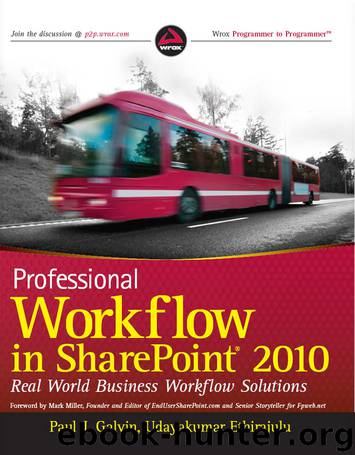Professional: Workflow in SharePoint® 2010 by Paul J. Galvin & Udayakumar Ethirajulu

Author:Paul J. Galvin & Udayakumar Ethirajulu
Language: eng
Format: epub
Publisher: John Wiley & Sons
Published: 2011-10-21T16:00:00+00:00
Estimates
Reliable estimates and forecasts are vital to the capital investment decision. A sophisticated process to analyze financial information and manage decisions related to a project is of little value if you take an informal approach to develop these estimates. The foundation for good capital planning is reliable forecasts and timely decisions. The estimate of the costs and benefits of a capital project should show the differential principle, which is the difference that result from making the investment and the change in cash flows as a result of undertaking the project.
The degree of precision necessary for the estimates related to the CAPEX decision depends on the stage of evaluation of the project, the sensitivity of the project’s economics to the level of accuracy and timing of each of the elements within the estimates, and if there is similarity of this expenditure to others already undertaken within the organization or industry.
If the investment is of a fixed nature such as equipment costs, installation, training, commissioning, initial spoilage and spare parts inventory, the CAPEX investment can usually be estimated with greater precision because capital investments occur in the near future, whereas operating costs and revenues are incurred over the life of the project. Bids from suppliers’ quick estimates can often be obtained because the values are often published and freely available.
If the CAPEX is the result of the replacement of existing equipment and/or the net cash inflows or outflows from the removal and disposal of that equipment, you need to take into account tax.
If the CAPEX involves working capital estimates, any analysis should include estimates of all investments required for a project, such as increases (or decreases) in cash, accounts receivable, accounts payable, or inventory. Include these changes in working capital and the changes at the end of the economic life of the project in your calculations.
Every CAPEX purchase has an economic life (planning horizon), which is difficult to estimate because you need to understand when the purchase is completely worn out or technically dated. Depending on the organization and industry, it can affect the optimism of this planning horizon.
Some organizations set an arbitrary limit on the planning horizon to be used in the analysis and are shorter than the estimated economic life of the project. Other organizations apply an arbitrary estimate of value for the benefits beyond the planning horizon.
With most CAPEX purchases there are operating costs. When estimating, consider the following:
Only cash costs after the payment of tax on income are relevant; noncash expenses such as depreciation are excluded except to the extent they affect taxable income.
Only future costs are relevant. Historical costs may be useful to provide a basis for prediction, but they do not represent the future costs.
Only consider the difference in cash operating costs between implementing or not implementing a proposal.
Include overtime or savings in the labor costs.
Download
This site does not store any files on its server. We only index and link to content provided by other sites. Please contact the content providers to delete copyright contents if any and email us, we'll remove relevant links or contents immediately.
Secrets of the JavaScript Ninja by John Resig Bear Bibeault(8594)
Implementing Enterprise Observability for Success by Manisha Agrawal and Karun Krishnannair(8182)
Supercharging Productivity with Trello by Brittany Joiner(7421)
Mastering Tableau 2023 - Fourth Edition by Marleen Meier(7181)
Inkscape by Example by István Szép(7061)
Visualize Complex Processes with Microsoft Visio by David J Parker & Šenaj Lelić(6751)
Build Stunning Real-time VFX with Unreal Engine 5 by Hrishikesh Andurlekar(5772)
Design Made Easy with Inkscape by Christopher Rogers(5052)
Customizing Microsoft Teams by Gopi Kondameda(4591)
Business Intelligence Career Master Plan by Eduardo Chavez & Danny Moncada(4538)
Extending Microsoft Power Apps with Power Apps Component Framework by Danish Naglekar(4195)
Salesforce Platform Enterprise Architecture - Fourth Edition by Andrew Fawcett(4076)
Pandas Cookbook by Theodore Petrou(4057)
Linux Device Driver Development Cookbook by Rodolfo Giometti(4022)
The Tableau Workshop by Sumit Gupta Sylvester Pinto Shweta Sankhe-Savale JC Gillet and Kenneth Michael Cherven(3863)
Exploring Microsoft Excel's Hidden Treasures by David Ringstrom(3349)
TCP IP by Todd Lammle(3134)
Applied Predictive Modeling by Max Kuhn & Kjell Johnson(3018)
Drawing Shortcuts: Developing Quick Drawing Skills Using Today's Technology by Leggitt Jim(2996)
